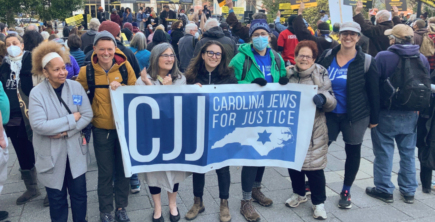The grantmaking process is not just a chance to make an impact; it’s also an opportunity to express your core values. When you do your part to equitably center grantees at every turn throughout the RFP process, you bolster engagement and connection with the communities involved, leading to true transformational change.
And, while this work requires intention and thought, it doesn’t have to be difficult. Small shifts and reframes as you move through the initial phases of creating your RFP make a world of difference.
Read on for five helpful tips we use at Tides Foundation to root our work in grantee-centered practices.
1. Decide Whether an RFP Is Truly Necessary
If you’ve ever been through the RFP process, you know it’s an arduous ask for proximate leaders and grassroots nonprofits. You only want to put potential grantees through it when it’s absolutely necessary for your decision-making. (Remember: If people are spending time filling out your application, they’re losing time to focus on other things.)
- To help determine if an RFP is the best way to accomplish your goal, ask these questions:
-
- What is the impact I’m seeking? Your vision, mission, objectives, and total funding amount will set the foundation for everything that follows, from the proposal guidance to review criteria.
- What information do I need to identify the partners who can achieve that impact? This reveals whether an RFP is the right tool for the job.
- If it turns out that an RFP is the most effective, equitable way to reach your goals, then proceed to the next step.
2. Only Request Information You Will Use in Your Decision-Making Process
When creating your RFP, be sure to include only as many steps as are necessary for your decision making.
- Verify that each section in your RFP directly relates to your review criteria. Consider the amount of effort you’re asking for, relative to the total amount of funding available. Is it proportional? If not, tailor the application until it is.
- To this end, consider whether a multi-step process could work, in which you accept a simpler, briefer application up front and follow up with finalists to request more detailed information.
- Additionally, if applicants can provide the information you need by sharing existing materials they’ve developed for other proposals, consider accepting those. Allowing prior materials submissions drastically cuts back on the amount of labor grantees face.
- Asking for only the necessary information results in better applications. Applicants can focus on explaining what matters instead of spending time on details that may not contribute to your final decision.
3. Be Clear in Your Instructions
Make sure the instructions you provide to applicants are clear and straightforward.
- Offer suggested word counts or other guidance on how long each response should be. If it’s practical to do so, offer templates for any requested attachments, such as project budgets. That way, applicants can see exactly what information you’re looking for in your review.
- If you’ve decided to accept prior materials, remind prospective grantees they can submit pre-existing annual reports or other proposals.
- It’s also a good idea to include the estimated time it will take an applicant to complete the RFP. This allows prospective grantees to properly plan ahead and submit applications on time.
4. Ask for Feedback While Drafting Your RFP
Just as you’re looking for a diverse group of applicants, you also want a well-rounded group of stakeholders and subject matter experts to offer feedback on your draft before it goes live.
- Consider bringing proximate community leaders into the RFP design from the beginning of the process, and be sure to compensate them appropriately for their time and expertise.
- You should also share your RFP with peer funders who are connected to the networks you want to reach. Ask for honest feedback, including criticism that challenges your assumptions and biases. This is a great way to identify any unconscious bias or areas of weakness within your application.
5. Consider Accessibility in your RFP Process
Every part of the RFP process is a chance to dismantle existing power imbalances between funder and grantee.
- To ensure your RFP is accessible to prospective grantees, consider accepting proposals in less traditional formats, such as videos and voice recordings, and in languages other than English.
- Offer spaces for prospective grantees to ask questions. Maybe you can organize an informational webinar session where people can learn more and ask clarifying questions. You might also put together an FAQ document addressing common questions and regularly update it as new information comes in.
- We recommend that you go through the entire RFP and fill it out, pretending you’re a prospective grantee. Is anything unclear or difficult to understand? Do any sections take longer than you thought they would? Is there anything in the RFP that might unintentionally dissuade certain groups from applying? Adjust as necessary before you send out your RFP.
Partner With Tides To Deepen Your Impact
As funders, we have a responsibility to trust and center the expertise of community leaders. Allowing them to shape and influence your RFP process is just one way to do that. These tips are a great starting point from which to evaluate your RFPs and move toward more equitable outcomes.
When you’re ready to go deeper, Tides can help. We partner with you to build power within historically excluded groups through a variety of grantmaking and investing solutions.
Want to learn more? Reach out to us, and let’s get started.
…………
Learn More About Grantmaking Best Practices
Blog 5 Grantmaking Best Practices To Create Maximum Impact
Blog Tides Foundation’s Principles of Grantmaking
Blog Dive Deeper: Advanced Practices for Equitable Grantmaking
PDF Grantmaking Best Practices
PDF Tides Request for Proposal (RFP) Best Practices





